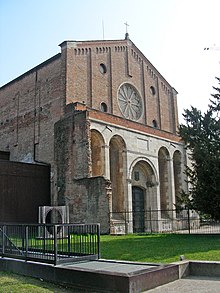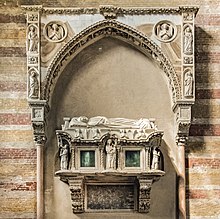Church of the Hermitans
The church of the Eremitani, ie the Augustinian hermits in Padua, is dedicated to the Apostles Philip and James the Younger and, like most church buildings in Italy, belongs to the Roman Catholic Church . In the 13th century it was built as a monastery church of the geanngen order. The north adjoining monastery area today houses the Musei civici, the city museums, with the Scrovegni Chapel . The church is famous for Andrea Mantegna's frescoes , which were largely destroyed in an air raid in 1944.
history
The church was built from 1276 in the style of the mendicant churches with three choir chapels and in 1306 it was given a wooden ceiling with a barrel vault, which is composed of two half and one whole barrel according to the design by Fra Giovanni degli Hermitage. In the same year he also planned the ceilings in the Palazzo della Ragione . In the front nave, the former choir of the fathers, the barrel vault consists of one barrel and six half-barrel. In the course of the Napoleonic secularization , the monastery was dissolved and is now a parish church of the Diocese of Padua. On March 11, 1944, the church was destroyed by an air raid. Only the lower part of the facade and the north walls remained. The reconstruction took place in 1946–1950, with the southern outer wall being built using the old bricks.
architecture
The facade corresponds to the facade type of the mendicant churches. Five arched niches are hidden in the basement. There are sarcophagi in the two side niches . The gable, in the middle of which there is a rose window, is structured by pilaster strips . The side portal with a canopy from 1442 remained undamaged.
Three choir chapels, the main chapel of which forms a pentagonal end, are also connected to the single-nave nave, which is similar to the type of mendicant churches. More chapels were later added on the south side.
inner space
In the rear of the church there are two Gothic tombs, on the left for Jacopo II da Carrara (early 14th century - 19 December 1350), ruler of Padua, with an inscription by Petrarch and on the right for Ubertino da Carrara († 1345), the Venetian sculptor Andriolo de Sanctis from the church of Sant'Agostino, which was demolished in the 19th century.
The large painted cross above the main altar from the 14th century was probably made by Guariento , who probably also painted the wall frescoes of the main choir, scenes from the life of Saints Philip and Augustine on the left and fragments of a Last Judgment in the apse .
To the south of the choir wall is the Ovetari family chapel, dedicated to Saints James the Elder and Christophorus , the painting of which the notary Antonio Ovetari ordered in his will. Originally, the older Giovanni d'Alemagna , Antonio Vivarini , a late Gothic Venetian painter, and the young Niccolò Pizzolo and Andrea Mantegna were commissioned with the painting. Giovanni d'Alemagna died after completing the garlands in the vault and Antonio Vivarini painted four evangelists. Her work was taken up by Bono da Ferrara and Ansuino da Forlì. Seventeen-year-old Andrea Mantegna painted three saints in the vault of the apse between Doctors of the Church from Pizzolo. Later Mantegna probably worked in the left lunette on the calling of the apostles James and John and the sermon of the apostle James , which he completed in 1450 before continuing to work on the central wall. From 1451 to 1453 the work was suspended due to a lack of financial resources and was resumed by Andrea Mantegna alone after Pizzolo's death from 1453 to 1457. He completed the scenes from the life of St. James the Elder , the Assumption of Mary on the middle wall and the scenes from the life of St. Christopher started by Bono da Ferrara and Ansuino da Forlì in the lower area and painted The Martyrdom of St. Christopher . Have survived the Assumption of Mary and The Martyrdom of St. Christopher , who had been removed because of their poor condition already in 1880, transferred to canvas and taken during the war in safety. A photograph of the fresco Martyrdom of St. James was attached in its original size to the left side wall and the fragments that had been preserved during the Allied bombing in 1944 were inserted. Only 77 square meters of the originally several hundred square meter fresco were saved in the form of 88,000 small fragments and put back together with the help of mathematicians.
Individual evidence
- ↑ Holger Dambeck: Destroyed Fresco: Mathematician puts together incomplete mega-puzzle . Spiegel Online . October 18, 2011. Retrieved March 1, 2016.
literature
- Reclam's art guide. Northern Italy East . Arranged by Erich Egg , Erich Hubala u. a. Stuttgart 1965. pp. 325-327.
Web links
Coordinates: 45 ° 24 ′ 38 " N , 11 ° 52 ′ 47" E




